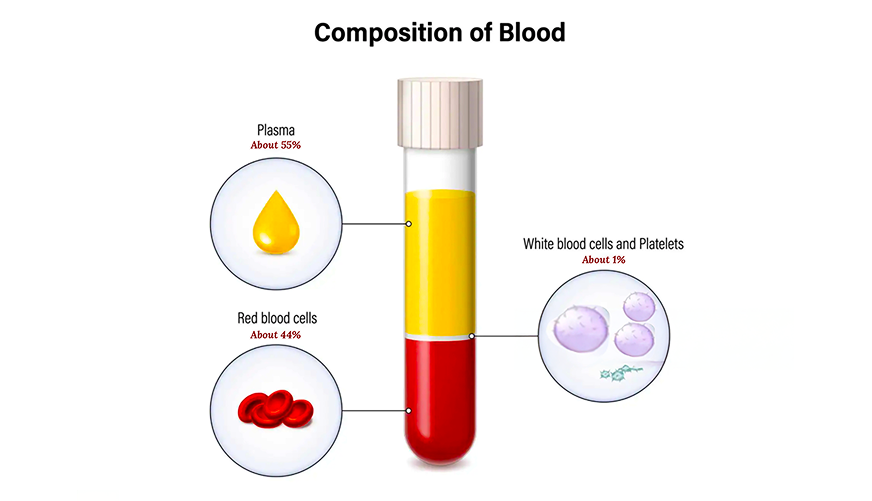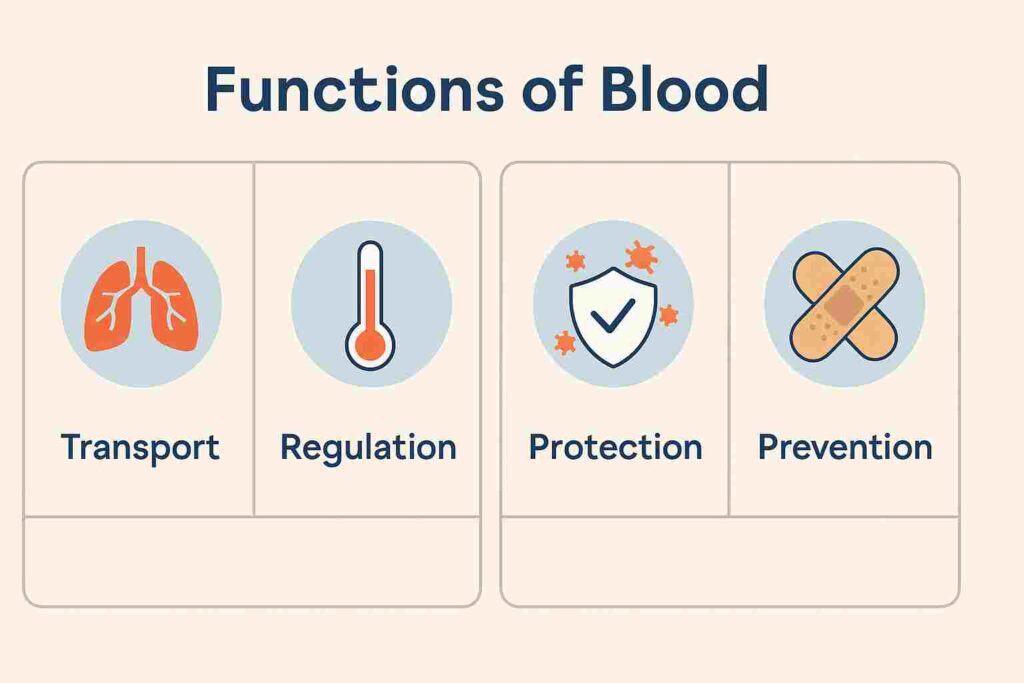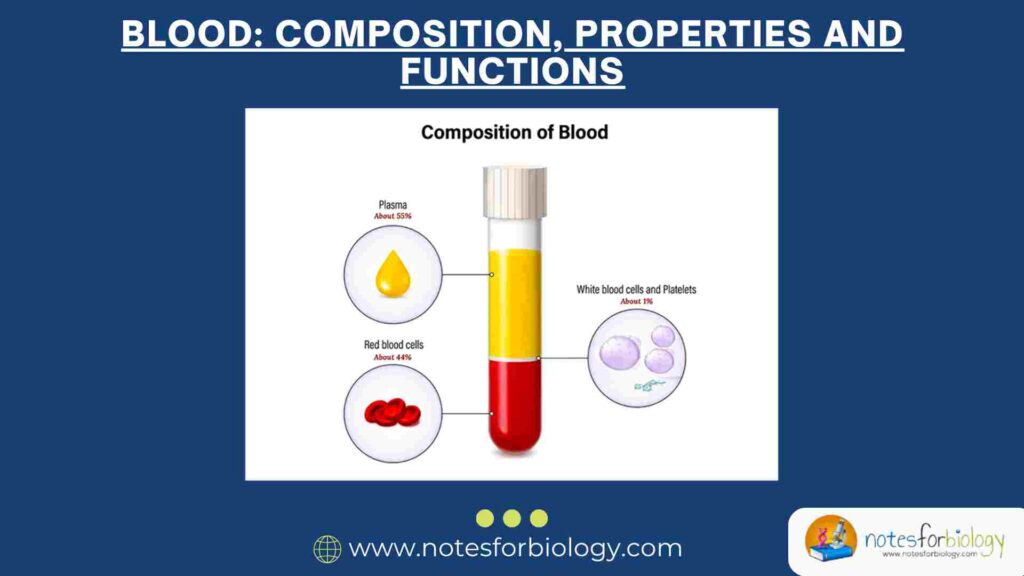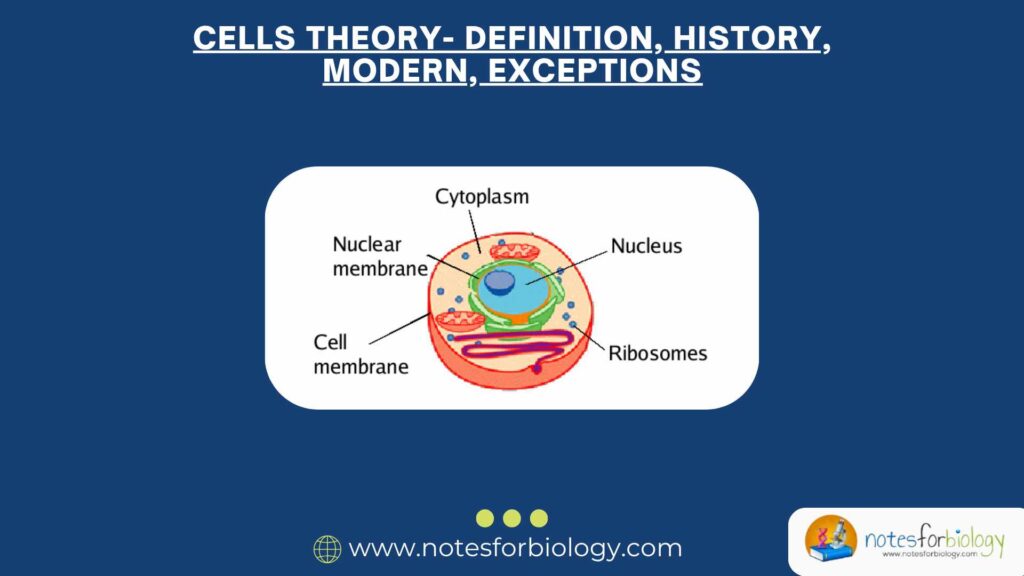What Is Blood?
Blood is a special fluid in our body that flows through a network of blood vessels like arteries, veins, and capillaries. It acts like a delivery service, carrying important things like oxygen and nutrients to all the cells in our body. At the same time, blood also helps remove waste materials like carbon dioxide from our cells. Besides transporting, blood helps regulate many body functions, keeps our body temperature steady, and protects us from infections.
Summary of Blood
- Blood is a vital fluid that transports oxygen, nutrients, and waste products throughout the body, ensuring every cell functions properly.
- It plays a key role in regulating body temperature, maintaining pH balance, and defending against infections.
- Understanding blood’s composition and functions highlights its essential role in sustaining life and overall health.
Table of Contents
Composition of Blood

Blood is made up of two main parts: plasma and formed elements.
Plasma
Plasma is the liquid part of blood. It looks like a pale yellow fluid and makes up a little more than half of the blood’s volume. Plasma carries many substances needed by the body, including:
- Mostly water (around 91%), which serves as a medium to carry other components.
- Proteins like albumin, globulins, and fibrinogen. Albumin helps keep the right amount of water in the blood vessels, globulins help with immune functions, and fibrinogen is important for blood clotting.
- Electrolytes such as sodium, potassium, and calcium, which help maintain the body’s pH and fluid balance.
- Nutrients like glucose (sugar), amino acids (building blocks of proteins), and fats that cells need for energy and growth.
- Waste products such as urea and creatinine, which need to be carried to the kidneys to be removed from the body.
- Gases like oxygen and carbon dioxide dissolved in the plasma.
- Hormones that travel to different parts of the body to control various processes.
Formed Elements
These are the solid parts of blood and include:
- Red blood cells (also called erythrocytes). These cells carry oxygen from the lungs to the rest of the body and bring carbon dioxide back to the lungs to be exhaled. They contain hemoglobin, a special protein that binds oxygen.
- White blood cells (or leukocytes). They fight off infections and protect the body from harmful invaders like bacteria and viruses. There are several types of white blood cells, each with a different role in the immune system.
- Platelets (also called thrombocytes). These small cell fragments help stop bleeding by forming clots at the site of an injury.
Properties of Blood

Blood has unique physical and chemical features that make it suitable for its many roles in the body.
- Blood is thicker than water. This thickness, or viscosity, helps control how it flows through the narrow blood vessels.
- The pH of blood is slightly alkaline, which means it is a bit basic rather than acidic. This balance (usually between 7.35 and 7.45) is very important for enzymes and other biochemical processes to work well.
- Blood is slightly warmer than the rest of the body, usually around 38 degrees Celsius. This helps keep body reactions efficient.
- The color of blood changes depending on whether it’s carrying oxygen or not. Oxygen-rich blood looks bright red, while oxygen-poor blood is darker.
Functions of Blood

Blood has several vital jobs to keep the body working well.
Transport
Blood transports oxygen from the lungs to all body tissues, helping cells produce energy. It also carries carbon dioxide, a waste product, back to the lungs to be breathed out. Blood carries nutrients absorbed from the digestive system to cells and takes away waste products to organs like the kidneys for removal. Additionally, blood carries hormones that regulate growth, metabolism, and many other body functions.
Regulation
Blood helps regulate the body’s temperature by distributing heat evenly. It also helps keep the pH level stable, so the body’s chemical reactions can happen smoothly. Blood controls the balance of fluids between the blood vessels and body tissues, thanks to the proteins in plasma that pull water where it’s needed.
Protection
White blood cells in the blood fight infections by attacking germs like bacteria and viruses. When you get injured, platelets and clotting proteins in blood work together to form clots that stop bleeding and begin the healing process.
Blood Disorders
Blood can be affected by different health problems, such as:
- Anemia, where there are not enough red blood cells or hemoglobin, causing fatigue and weakness.
- Leukemia, a cancer that affects white blood cells, reducing the body’s ability to fight infections.
- Hemophilia, a genetic disorder where blood doesn’t clot properly, leading to excessive bleeding even from minor injuries.
- Polycythemia, a condition where there are too many red blood cells, making blood thicker and increasing the risk of clots.
Blood Test
Doctors use blood tests to check health and diagnose diseases. Some common tests include:
- Complete Blood Count (CBC), which measures the levels of different blood cells and helps detect conditions like anemia or infections.
- Blood chemistry tests, which check the levels of glucose, electrolytes, and other substances to assess organ function.
- Coagulation tests, which check how well the blood clots.
Blood Cell Production and Lifespan
Blood cells are made in the bone marrow through a process called hematopoiesis.
- Red blood cells take about a week to develop and live for about 120 days.
- White blood cells have different lifespans depending on their type, ranging from hours to years.
- Platelets are produced from large cells called megakaryocytes and live about 7 to 10 days.
Blood Circulation
Blood flows continuously through the heart and blood vessels in a closed circuit.
The heart pumps oxygen-rich blood into arteries, which deliver it to tissues. Tiny capillaries allow oxygen and nutrients to pass to cells while waste products move into the blood. Veins carry oxygen-poor blood back to the heart, which sends it to the lungs for oxygen.
Maintaining Healthy Blood
Good blood health depends on a balanced diet rich in iron, vitamins, and minerals, which supports the production of healthy blood cells. Regular exercise improves circulation and oxygen delivery. Drinking enough water keeps blood volume and thickness at proper levels. Routine medical check-ups can help detect blood problems early for timely treatment.
Conclusion
Blood is an essential fluid that supports life in many ways. It delivers oxygen and nutrients, removes wastes, regulates body temperature and pH, and protects us from infections. Understanding blood’s composition and functions helps us appreciate how our bodies stay healthy and how to care for this life-sustaining fluid through good lifestyle choices and medical care.
Frequently Asked Questions (FAQs)
What is blood?
Blood is a special liquid that flows through our body in blood vessels. It carries vital substances like oxygen and nutrients to cells, removes waste products, and helps keep our body healthy.
What are the main parts of blood?
Blood is mainly made up of plasma and formed elements. Plasma is the liquid part that carries nutrients and waste, while formed elements include red blood cells (which transport oxygen), white blood cells (which fight germs), and platelets (which help stop bleeding).
What are the key functions of blood?
Blood has several important roles: it transports oxygen and nutrients, regulates body temperature and pH balance, and protects the body by fighting infections and forming clots to prevent excessive bleeding.
Related Articles




